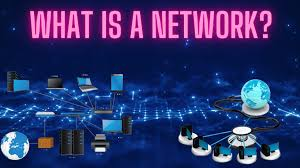Introduction to the Network of Networks
The concept of a “network of networks” forms the foundational framework for understanding modern connectivity in our increasingly digitized world. At its core, this idea encapsulates the interconnectedness of various separate networks—typically composed of smaller, local networks that combine to form a more extensive global infrastructure. The most prominent example of this is the internet, which serves as a massive network of networks, enabling communication and data exchange across vast distances and among diverse devices and systems.
Within this framework, several types of networks operate concurrently, ranging from private local area networks (LANs), which facilitate communication within a limited area such as an office or home, to larger metropolitan area networks (MANs) and wide area networks (WANs) that cover broader geographical regions. Each of these networks adheres to standard protocols that allow disparate systems to interconnect seamlessly, ensuring consistent data transmission and resource sharing. Importantly, the interdependence of these networks highlights the need for robust infrastructure and effective protocols, which can adapt and evolve in response to emerging technological advancements.
This network of networks is not only about facilitating efficient communication; it also enables a multitude of services and applications that are vital for personal, educational, and business purposes. From cloud computing and virtual private networks (VPNs) to social media and e-commerce, the interconnected nature of these networks enhances accessibility, responsiveness, and overall user experience. As we delve deeper into the significance of this complex system, it becomes clear that understanding the network of networks is essential for navigating the intricate digital landscape that continues to evolve at an unprecedented rate.
Historical Context and Evolution
The history of networking is rooted in the desire for efficient communication over long distances. Early communication systems, such as the telegraph in the 1830s, marked the beginning of wired communication, enabling the transmission of messages over vast distances almost instantaneously. This technological innovation laid the groundwork for more complex systems that would eventually evolve into the modern network of networks.
A significant milestone in networking history was the development of ARPANET in the late 1960s. Funded by the United States Department of Defense, ARPANET was the first network to implement the packet-switching concept, which divided data into smaller packets for transmission. This innovative approach allowed multiple devices to communicate concurrently over a single network, paving the way for the interconnected fabric of today’s internet. The first message sent over ARPANET in 1969 marked a pivotal moment in the evolution of networking, demonstrating the potential for digital communication across multiple locations.
The evolution continued through the 1970s and 1980s with the introduction of various protocols that standardized how data was transmitted across networks. The development of the Transmission Control Protocol (TCP) and the Internet Protocol (IP) established the fundamental architecture that underpins the modern internet. As more computers and devices were interconnected, the concept of a “network of networks” began to take shape, allowing disparate systems to communicate seamlessly.
The advent of the World Wide Web in the early 1990s further accelerated networking growth, providing an accessible interface for users and making information widely available. This democratization of knowledge and networking facilitated a significant cultural shift, where information could be shared and disseminated globally. As we moved into the 21st century, the emergence of mobile technologies and wireless networks further transformed connectivity, leading to the expansive and intricate networks we rely on today.
How Networks Interconnect
The interconnectivity of networks forms the foundation of modern communication, allowing diverse systems to share information seamlessly. At the heart of this process are networking protocols, which are sets of rules and conventions that define how data is transmitted, received, and interpreted across various systems. These protocols ensure that devices, regardless of their underlying architecture or operating systems, can effectively communicate with one another. Common examples include the Transmission Control Protocol (TCP) and the Internet Protocol (IP), which manage how data packets are sent and received over the internet.
Routing is another critical aspect of network interconnections. Routers act as intermediaries that direct data packets toward their designated destinations by selecting optimal pathways through interconnected networks. When a packet of data is transmitted, it may traverse multiple networks and routers before reaching its endpoint. Each router performs a series of computations to determine the best route based on a variety of factors, including network congestion, traffic patterns, and the specific protocols in use. This dynamic routing ensures that communication remains efficient and responsive, enhancing the user experience across various applications and services.
Internet Service Providers (ISPs) play a pivotal role in facilitating network interconnectivity. ISPs are responsible for connecting individual users and businesses to the larger ecosystem of networks that comprise the internet. They maintain extensive backbone infrastructures and establish connections with other ISPs, enabling data to flow between different regions and countries. Through peering agreements and transit arrangements, ISPs create pathways for information to travel, ensuring that users can communicate without interruption or delay.
The interaction of protocols, routing mechanisms, and ISPs illustrates the intricate web of networks working together to create a functional and accessible communication environment. Understanding these components is vital for grasping how data travels across the modern network of networks.
The Role of Protocols in Networking
Protocols play a fundamental role in the domain of networking, acting as the essential rules and standards that enable devices to communicate with one another. In the context of the internet, these protocols form a complex framework known as the “network of networks,” allowing for seamless data transfer and connectivity among millions of devices globally. Various protocols serve specific purposes, and understanding a few key examples can provide insight into their critical functions.
The Transmission Control Protocol (TCP) and Internet Protocol (IP) are two of the most significant protocols that serve as the backbone of modern networking. TCP facilitates the reliable transmission of data by establishing a connection between a sender and receiver, ensuring that packets of data are sent and received in the correct order. This is crucial for maintaining the integrity of information, especially in applications such as email, file transfers, and web browsing. On the other hand, IP is responsible for addressing and routing packets across networks, determining the most efficient paths for data to reach its destination.
Another essential protocol is the Hypertext Transfer Protocol (HTTP), which underlies the functioning of the World Wide Web. HTTP enables the transfer of hypertext documents, allowing users to access web pages and interact with multimedia content. With the introduction of HTTPS, a secure version of HTTP, user data is further protected during transmission, addressing growing concerns about privacy and security in digital communication.
Moreover, protocols like File Transfer Protocol (FTP) and Simple Mail Transfer Protocol (SMTP) exemplify the specialization found within networking protocols, catering to distinct tasks such as file sharing and email transmission. Overall, the synergy between these various protocols not only optimizes communication within networks but also fosters global connectivity, reinforcing the essential framework that supports the modern digital landscape.
Challenges Faced by the Network of Networks
The network of networks, fundamentally essential to modern connectivity, encounters a myriad of challenges that can significantly impact its functionality and reliability. One of the primary concerns is the ever-evolving landscape of security threats. With an increasing reliance on interconnected systems, cyber-attacks such as Distributed Denial of Service (DDoS) attacks, ransomware, and data breaches have become more prevalent. These threats not only compromise sensitive information but also disrupt services, leading to extensive financial and reputational damage for organizations.
Another significant challenge revolves around data privacy issues. As the network of networks facilitates vast amounts of data transfer, the potential for unauthorized access and misuse has risen. Regulations like the General Data Protection Regulation (GDPR) emphasize the necessity for organizations to protect personal data rigorously. Non-compliance can result in severe penalties, prompting businesses to invest in robust cybersecurity measures. However, balancing privacy with the need for data accessibility remains a complex issue.
Additionally, managing network congestion is a persistent challenge that impacts the performance of internet services. With an exponential increase in internet users and devices, particularly with the rise of IoT, networks often face bottlenecks that can degrade user experience. High traffic volumes can lead to latency, packet loss, and interrupted connections. Solutions being explored include the implementation of more efficient routing protocols, the deployment of additional bandwidth, and the utilization of network slicing to ensure that critical applications have round-the-clock availability.
Organizations and users alike must navigate these challenges while seeking effective solutions. As technology progresses, the integration of advanced tools for security, privacy protection, and traffic management will be crucial in sustaining the integrity and efficiency of the network of networks.
Future Trends and Innovations
The landscape of networking is undergoing a significant transformation driven by emerging technologies. At the forefront of this evolution is 5G, which promises to revolutionize connectivity standards. With substantially higher speeds, lowered latency, and increased capacity, 5G is set to facilitate a more interconnected environment, enabling more devices to communicate simultaneously. This advancement plays a critical role in supporting the Internet of Things (IoT), which relies on seamless connectivity among numerous devices, from household appliances to industrial machinery. As these technologies converge, the potential for real-time data exchange grows, propelling a new era of responsive systems.
In addition to 5G, the integration of artificial intelligence (AI) into networking practices is poised to enhance operational efficiencies. AI can analyze vast amounts of data swiftly, allowing for improved network management. By predicting potential disruptions or optimizing traffic flow, AI technology facilitates more efficient resource allocation, ensuring a resilient and reliable network. This efficient utilization of network resources becomes increasingly vital as the demand for connectivity grows, driven by applications such as smart cities and autonomous vehicles.
Furthermore, innovations in edge computing are also set to play a pivotal role in the future of the network of networks. By processing data closer to the source, edge computing reduces the time it takes for data to travel across the network, further minimizing latency. This capability is crucial for applications that require immediate responsiveness, such as telemedicine, augmented reality, and real-time analytics. The combination of 5G, AI, and edge computing creates a robust framework that not only supports existing practices but also motivates the development of novel solutions.
As we look ahead, it is evident that the integration of these technologies will shape the functionality of the network of networks, enhancing the overall connectivity ecosystem. Businesses and individuals alike will benefit from these advancements, fostering more efficient and innovative solutions across various sectors.
The Importance of Interoperability
Interoperability plays a vital role in the functioning of the network of networks, underpinning modern connectivity. It refers to the capacity of different networks to communicate and operate seamlessly with one another. This ability is increasingly important as diverse systems, protocols, and platforms emerge in a fast-evolving digital landscape. Ensuring interoperability facilitates the efficient exchange of data and resources across networks, ultimately enhancing overall performance and user experience. Organizations cannot afford to operate in silos; collaboration amongst different network operators and service providers is crucial for optimized connectivity.
One of the key factors contributing to the effectiveness of interoperability is the standardization of protocols and frameworks. By establishing universal standards, stakeholders can ensure that various technologies can interlink smoothly, reducing compatibility issues and improving service delivery. These standards promote a common understanding of operational procedures, technical specifications, and data formats, allowing for enhanced integration efforts. Recent initiatives aimed at developing open standards within the tech industry highlight the commitment to achieve this goal, fostering a sustainable environment for innovation.
Additionally, the need for interoperability resonates within various sectors such as telecommunications, cybersecurity, and cloud computing. In telecommunications, for instance, seamless communication between networks is essential for customer satisfaction and business continuity. Likewise, in cloud computing, interoperability allows users to switch between service providers without facing significant hurdles. As organizations continue to invest in their network infrastructures, collaboration among industry players is imperative to ensure the collective growth and efficiency of the digital ecosystem.
Overall, the importance of interoperability in the network of networks cannot be overstated. It not only facilitates real-time communication and data sharing but also encourages innovation and competitive advantages among organizations. By prioritizing interoperability, stakeholders can unlock the full potential of interconnected systems, ensuring a more cohesive and resilient digital environment for the future.
Implications for Businesses and Consumers
The network of networks, commonly referred to as the internet, plays a pivotal role in shaping contemporary commerce and consumer experiences. For businesses, the implications are profound, as it has revolutionized the way companies operate, communicate, and engage with their clientele. The interconnected infrastructure allows firms to optimize their operations through improved efficiency and innovation. By leveraging this extensive network, businesses can seamlessly connect with suppliers, partners, and customers across the globe, driving growth and expansion into new markets.
Moreover, access to vast amounts of data facilitated by the network empowers enterprises to make informed decisions. They can analyze consumer behavior, track market trends, and customize services to meet evolving consumer demands. This not only enhances operational efficiency but also leads to the development of innovative products and services that cater to a wider audience. As a result, companies can gain a competitive edge, streamline their processes, and ultimately increase profitability.
On the consumer front, the benefits of this interconnected network are equally significant. Improved connectivity enhances the accessibility of services, enabling individuals to enjoy various conveniences, from e-commerce and online banking to telehealth services and remote work opportunities. Consumers are now able to engage with businesses 24/7, fostering an environment of immediacy and convenience that was previously unattainable. Moreover, the network of networks encourages competition among service providers, resulting in better quality, lower prices, and diversified options for consumers.
In this rapidly evolving digital landscape, both businesses and consumers stand to benefit from the synergies created by interconnected networks. As technology continues to advance, those who harness the power of these networks will thrive in an increasingly connected world, shaping the future of commerce and consumer experiences alike.
Conclusion: The Future of Connectivity
As we have explored throughout this blog post, the concept of the network of networks represents a revolutionary framework that fundamentally supports modern connectivity. This intricate architecture allows for seamless communication between various entities, enhancing the way individuals and organizations interact on a global scale. From the inception of the internet to the present day, the evolution of communication technologies has showcased the pivotal role of interconnected networks in shaping our society.
Moving forward, it is essential to recognize the implications of this interconnectedness on future connectivity solutions. With the rapid technological advancements, including the proliferation of 5G networks and the expansion of the Internet of Things (IoT), the connectivity landscape is expected to undergo significant transformations. These innovations will likely facilitate even greater data exchange, enhance mobile connectivity, and support real-time communication across diverse platforms, creating a more integrated world.
Moreover, as the demand for reliable and efficient networks increases, the ongoing development of infrastructure will play a critical role in sustaining this interconnected ecosystem. This includes not only advancements in traditional network structures but also the exploration of alternative technologies such as satellite internet and mesh networks. The future of connectivity, therefore, hinges on our ability to adapt to these changes and explore innovative solutions that cater to the evolving needs of users.
In light of these developments, readers are encouraged to remain engaged and informed about the dynamic realm of connectivity. By understanding the implications of the network of networks, individuals can better appreciate the changing landscape of communication and anticipate the advancements that lie ahead. The future of connectivity is not only a matter of technological progress but also one that shapes the way we connect, collaborate, and thrive as a global society.
How useful was this post?
Click on a star to rate it!
Average rating 0 / 5. Vote count: 0
No votes so far! Be the first to rate this post.

















